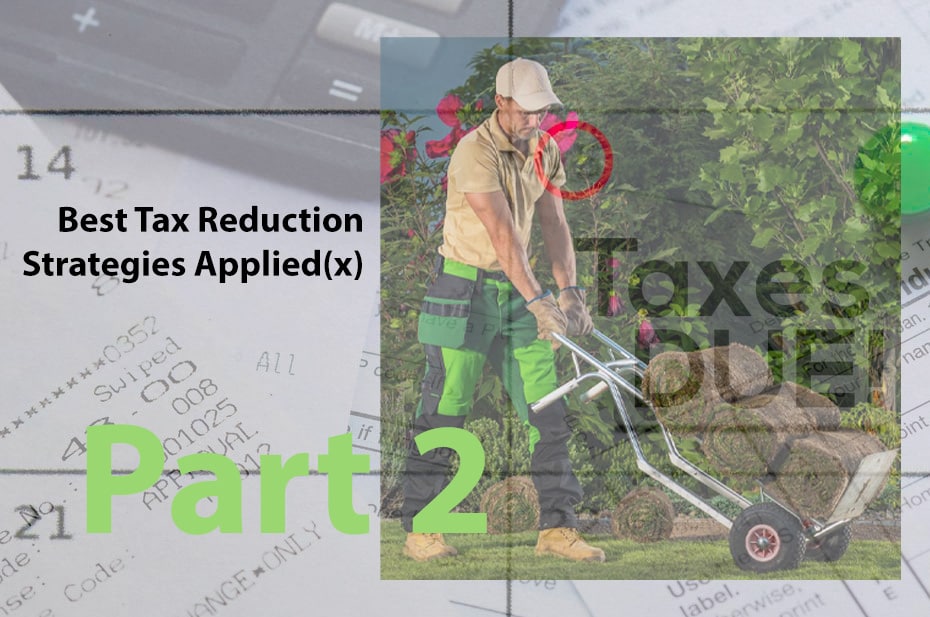Lawn and landscape business owners are always interested in learning more about reducing their tax bills. When you know that the Internal Revenue Service (IRS) published tax code has over 17,000 pages of rules and regulations, plus countless pages of guidance from tax court cases over the years, it’s easy to understand it’s nearly impossible to learn all of the tax rules that may help you reduce your taxes.
Most business owners rely on a relationship with a Certified Public Accountant (CPA), Tax Attorney, or an Enrolled Agent for sound tax advice. However, we have learned that no one will ever care as much about YOUR MONEY as you do. With this in mind, we believe every business owner should commit to learning about tax reduction strategies on an ongoing basis.
We published part 1 of the Tax Reduction Report for lawn and landscape business owners with the goal of helping business owners understand that ultimately, YOU are responsible for lowering your taxes. In case you missed that report, you can learn more by clicking here.
This way, you are better prepared to discuss tax reduction with your advisors and request guidance on strategies that could lower your tax bill. After all, if you hope to become the Wealthy Landscaper as you beautify your part of the world, you’ll need to keep as much of your money as possible.
Tax laws change as often as lawmakers pass new laws and implement new regulations. Rarely does a year pass without a change in tax code. So your opportunity to learn about tax reduction NEVER ends. Keep this in mind. You’ll never be finished learning about tax reduction strategies.
The tax reduction strategies we discuss below will change over time. But as we publish this report, these are currently available to businesses or individual taxpayers. Please consult with your CPA, Tax Attorney or Enrolled Agent for tax advice. This article is not intended to provide tax or legal advice. It is intended to provide general information on the subject of tax credits for lawn and landscape business owners.
Powerful Tax Credit Strategies for Landscapers
Solar Energy Tax Credit (IC)
The federal government has made a commitment to lower greenhouse gas emissions. They believe the best way to do this is to encourage people to invest in solar energy generation projects. For those companies who follow through with the installation of a solar power generation system, they can claim an investment tax credit equal to 30% of the capital cost of the project. This tax credit is set at 30% of the capital cost of the project from 2023 to 2033.
If you decide to install a solar power system on your commercial property, you may be eligible for this investment tax credit. This is also available to homeowners who install solar power at the residence. If you like to idea of lowering your power bill, claiming a tax credit and lowering greenhouse gasses, here’s your big opportunity.
Here’s an interesting option to consider. Have you considered making the switch to battery powered lawn equipment? Many lawn service contractors are making the transition to battery powered lawn equipment. But there is a hurdle. Batteries are very expensive. They must be recharged after each use.
At Super Lawn Trucks, we developed the Solar Lawn Truck system to provide an off-grid on-the-go charging system for lawn and landscape contractors who want to use battery powered lawn equipment. The Solar Lawn Truck charging system is an advanced energy project. The companies who invest in this equipment can claim a 30% tax credit. More here.
Please keep this in mind. Tax credits are not worth a dime to a company that does not generate profits. Regardless if you are installing solar power generation on your building or on your truck, you need to have profits to claim your tax credit.
Employee Retention Tax Credit (ERC)
The pandemic of 2020 changed a tremendous amount about the way we work, the way we feel about work and human behavior. When the government shut down our economy, they created significant hardships for many businesses and the families who worked there.
In our opinion, they created the employee retention tax credit as a special reward for those employers who did not lay off their employees. Every employer has to pass a series of qualifying questions to determine eligibility for this tax credit. But it appears that a tremendous amount of landscape businesses are eligible. After all, most of us continued to work throughout the period of time governments had mandated shutdowns.
This is a unique tax credit. This actually generates a cash refund for payroll taxes you have paid to the IRS. We’ve spoken with a number of contractors (under 100 employees) who have received six figure refunds by claiming this tax credit. You can receive it even if your company received the Payroll Protection Program (PPP) grant. You can receive it even if your sales grew during the period.
The business can claim up to $26,000 per employee they kept on payroll for the period of time March 12, 2020 to January 1, 2021. As we write this article, it appears your right to claim this tax credit will expire in July of 2023.
One special note. There has been widespread advertising by companies who offer services to file the appropriate tax credit paperwork on your behalf. They offer to do this work on a fee basis if you receive the tax credit refund. Please do your own research and speak with your tax advisor about this tax credit opportunity.
Electric Vehicle Tax Credit (EVTC)
If you purchase an all electric vehicle, you can receive up to $7500 as a tax credit. As we described above in the explanation of the solar tax credit, you will be making a purchase in order to claim this tax credit.
The federal government has decided to encourage the adoption of electric vehicles in our country. So, they are offering this incentive to speed up the wide-spread use of electric vehicles. As with all tax credits, there are a number of qualifying questions you must answer to make sure the vehicle you purchase qualifies for the EVTC.
Work Opportunity Tax Credit (WOTC)
Employers can be rewarded with a tax credit of up to $2400 per employee when you hire certain types of people. People that have been long-term unemployed, those who receive government assistance or those recently released from prison are examples of those who may be eligible for the WOTC.
Each state designates areas they call Empowerment Zones. Hiring people from these areas or locating your business in one of these areas may create opportunities for tax credits for jobs you create and people you hire. Tax credits may come in the form of federal tax credits or state tax credits or both.
Summary
We believe that 80% of all lawn and landscape business owners are overpaying their taxes each year. This is unlikely to change. Tax code is complicated. Tax advisors charge high fees for their services. It takes time to think through business decisions that lead to tax credits like those described above.
Unfortunately, many lawn and landscape business owners don’t spend enough time talking to their CPA, tax attorney or enrolled agent for tax reduction guidance. And, for many business owners, they count on their advisors to provide all the guidance they need. Our experience clearly shows that learning tax reduction strategies is a wealthy habit worth further study.
If you own a lawn or landscape company and you would like further training on wealth accumulation from your business, contact us at Tony@TonyBassConsulting.com or call us 478-822-9706.

